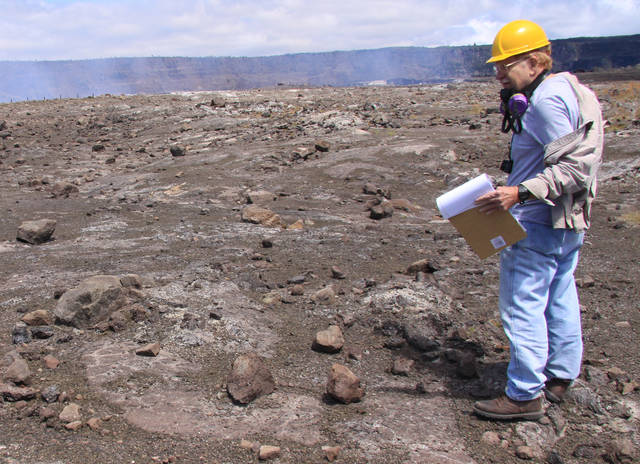“Ben, do we have a photo of … ?” ADVERTISING “Ben, do we have a photo of … ?” This seemingly simple question is asked every week of Ben Gaddis, retired judge and photo archive volunteer at the USGS Hawaiian
“Ben, do we have a photo of … ?”
This seemingly simple question is asked every week of Ben Gaddis, retired judge and photo archive volunteer at the USGS Hawaiian Volcano Observatory.
Ever since he learned about Parícutin’s eruption in a cornfield in Michoacán, Mexico, as a youngster, Ben has been fascinated by volcanoes. In 1970, his interest drove him to move with his wife, Mary, from Texas to Hawaii. A course in volcanology at the University of Hawaii at Hilo led to associations with HVO and, subsequently, to helping with field work on weekends during the eruptions of both Mauna Ulu and Pu‘u ‘O‘o until 1986, when his duties as a judge left him no time for volcano monitoring.
After retiring in 2008, Ben decided to devote more time to helping HVO. His volunteer work in the photo archive began when Frank Trusdell, HVO’s Mauna Loa scientist, engaged his services to scan 35 mm slides for public presentations and publications.
HVO’s collection of more than 300,000 images dates back to the mid-1800s, when the first photograph of Kilauea Volcano (that we know of) was taken. Like many other institutions and individuals with collections of pre-digital photographs, negatives, and prints, HVO’s long-term goal is to scan and archive its images to preserve them for posterity.
Since 2009, Ben has organized, labeled, scanned and entered metadata for thousands of color slides and black and white photos. In order to make the digitized images more accessible to researchers and to the public, he created an image catalog searchable by name of photographer, ID, date, event, location and keywords.
Ben often goes the extra mile to research and correct erroneous information, thereby increasing the scientific value of the images. Among the treasures he discovered while rummaging through old materials were unpublished administrative records on the early days of HVO and the explosive eruption of Kilauea in 1924. His work resulted in public presentations by Ben and HVO scientists Don Swanson and Jim Kauahikaua on historical eruptions, illuminated by the newly discovered images.
With the opportunity and vision to go beyond the limits of HVO’s collection, Ben took snapshots of museum collections (with permission), increasing staff access to those resources and, at the same time, promoting awareness of the museums’ holdings through collaborative outreach.
Ben used the expanded collections to assist scientists — through the evidence of images — in illustrating and refining their ideas and observations about geological processes and eruption dynamics on the Island of Hawaii. These insights have facilitated HVO’s work in hazards mitigation, increased awareness during eruptions and seismic crises, and enhanced publications, public lectures, outreach activities, and educational forums.
In addition to HVO, Ben has served the National Park Service, Hawaii County Civil Defense, publishers, writers, artists, engineers, exhibit coordinators of museums all over the world, and scientists, teachers, and students of all ages. He considers his volunteer work a labor of love, and we are profoundly grateful for his singular, peerless contributions to the USGS-HVO’s work and to the Department of Interior’s mission.
For all of this and more, Ben was recently honored by the U.S. Geological Survey for his many years of service as HVO’s volunteer photo archivist. Congratulations, Ben, on receiving the U.S. Department of Interior’s “Citizen’s Award for Exceptional Service!”
As a historical note, volunteers have been a crucial part of HVO since the early days of scientific study at Kilauea. In 1911, volunteers helped scientist Frank Perret erect A-frame supports for a cable across Halemaumau Crater to measure temperatures in “Old Faithful.” Also, when operational funds were scarce, as they were during the 1924 explosive eruption, volunteers from the community pitched in to help HVO record details of the eruption. Volunteers were also key to HVO operations during the Great Depression.
Volcano Watch is a weekly article and activity update written by U.S. Geological Survey Hawaiian Volcano Observatory scientists.
Volcano Activity Updates
This past week, Kilauea Volcano’s summit lava lake continued to rise and fall in concert with summit inflation and deflation. On the East Rift Zone, the 61g flow was still active, with lava entering the ocean near Kamokuna and surface breakouts downslope of Pu‘u ‘O‘o. These flows do not pose an immediate threat to nearby communities.
Mauna Loa is not erupting. During the past week, small-magnitude earthquakes were recorded primarily beneath the upper west flank of the volcano, with most at depths of 3-8 miles. GPS measurements continue to show deformation related to inflation of a magma reservoir beneath the summit and upper Southwest Rift Zone. No significant changes in volcanic gas emissions were measured.
One earthquake was reported felt on the Island of Hawaii in the past week. At 12:16 a.m. on April 14, a magnitude-2.8 earthquake occurred 3.3 miles southeast of Kilauea Volcano’s summit at 1.7 miles depth.
Visit https://hvo.wr.usgs.gov for past Volcano Watch articles, Kilauea daily eruption updates, Mauna Loa weekly updates, volcano photos, recent earthquakes info, and more; call for summary updates at (808) 967-8862 (Kilauea) or (808) 967-8866 (Mauna Loa); email questions to askHVO@usgs.gov.



